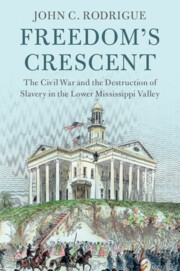Book contents
- Freedom’s Crescent
- Cambridge Studies on the American South
- Freedom’s Crescent
- Copyright page
- Dedication
- Epigraph
- Contents
- Figures
- Acknowledgments
- Abbreviations
- Additional material
- Introduction
- Prologue Life – and Labor – on the Mississippi
- Part I From War for Union to Military Emancipation, 1860–1862
- Part II From Military Emancipation to State Abolition, 1863
- Part III Abolition: State and Federal, 1864
- Part IV The Destruction of Slavery, 1865
- 18 “The Tyrants Rod Has Been Broken”
- 19 “This Cup of Liberty”
- 20 “Establish Things as They Were Before the War”
- 21 “The Institution of Slavery Having Been Destroyed”
- 22 “Americans in America, One and Indivisible”
- Epilogue Memphis and New Orleans: May 1–3 and July 30, 1866
- Bibliography
- Index
19 - “This Cup of Liberty”
from Part IV - The Destruction of Slavery, 1865
Published online by Cambridge University Press: 19 January 2023
- Freedom’s Crescent
- Cambridge Studies on the American South
- Freedom’s Crescent
- Copyright page
- Dedication
- Epigraph
- Contents
- Figures
- Acknowledgments
- Abbreviations
- Additional material
- Introduction
- Prologue Life – and Labor – on the Mississippi
- Part I From War for Union to Military Emancipation, 1860–1862
- Part II From Military Emancipation to State Abolition, 1863
- Part III Abolition: State and Federal, 1864
- Part IV The Destruction of Slavery, 1865
- 18 “The Tyrants Rod Has Been Broken”
- 19 “This Cup of Liberty”
- 20 “Establish Things as They Were Before the War”
- 21 “The Institution of Slavery Having Been Destroyed”
- 22 “Americans in America, One and Indivisible”
- Epilogue Memphis and New Orleans: May 1–3 and July 30, 1866
- Bibliography
- Index
Summary
During winter and spring of 1865, Tennessee amendments gain voter approval, abolishing slavery in the state, and loyalist government elected and inaugurated. Legislatures of Louisiana, Arkansas, and Tennessee approve Thirteenth Amendment. Lincoln and congressional Republicans fail to reach accord on Reconstruction legislation before Congress adjourns in early March, and Congress refuses to seat Louisiana and Arkansas claimants but creates Freedmen’s Bureau. Lincoln’s Second Inaugural Address promises reconciliation for former Confederates and justice for freedpeople. Following Lee’s surrender, Lincoln’s “last” address defends his Reconstruction policy and the Louisiana government, although Lincoln also for the first time publicly endorses black suffrage and acknowledges black role in Reconstruction. Confederate surrender in western theater takes several more weeks. Andrew Johnson announces Reconstruction policy in late May 1865, recognizing governments of Tennessee, Arkansas, and Louisiana but rejecting calls for black role in Reconstruction.
- Type
- Chapter
- Information
- Freedom's CrescentThe Civil War and the Destruction of Slavery in the Lower Mississippi Valley, pp. 377 - 395Publisher: Cambridge University PressPrint publication year: 2023

